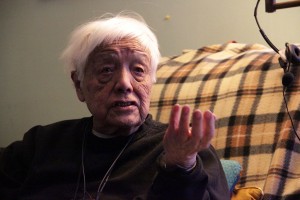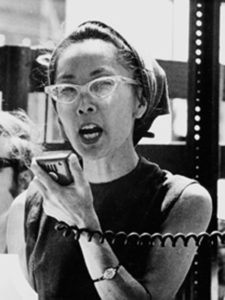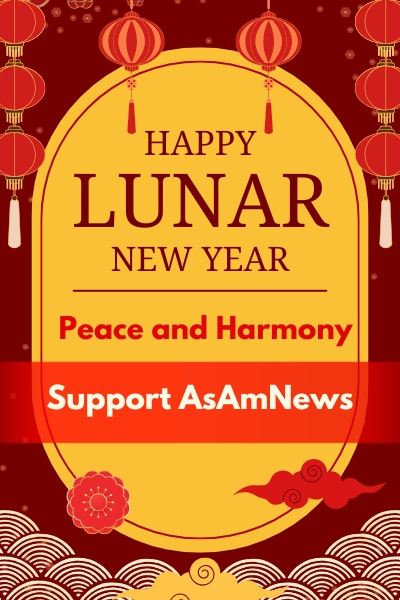 By Sudip Bhattacharya
By Sudip Bhattacharya
AsAmNews Staff Writer
In the late 1960s, philosopher and activist, Grace Lee Boggs understood that foundations were starting to shift.
“What we saw and heard was that Americans were thinking and talking and wondering about revolution as they had not done for nearly two hundred years,” she expressed in her autobiography Living for Change, adding a few lines later, “Americans were beginning to feel that the bottom had fallen out of the society. Old beliefs were crumbling, existing institutions were no longer working, and even more than in the Great Depression of the 1930s great numbers of people were looking for new ways to think and act for themselves.”
I believe we’re at a similar point in history, as protests swell to combat the hate and prejudice from those clinging to power. Movements such as BLM continue to raise the consciousness and more young people have begun to connect institutional and personal politics. Most importantly, there are opportunities for coalitions to form and take root, especially between Asian Americans and Black/African Americans.
Moving forward, two individuals should serve as blueprints for how we as Asian American can become better allies for Black liberation: Grace Lee Boggs and Yuri Kochiyama.
Grace Lee grew up in New York City as a Chinese American. Although more insulated from the ravages of the Great Depression, since her father was a businessman, Grace was still able to see and feel the racism and inequality around her. This spurred her to think deeply about issues of change and social justice, leading her to Chicago and finally, to Detroit. Along the way, her circle of friends expanded to include icons like C.L.R James, famous for his work on the Haitian freedom fighter Toussaint L’Overture. Eventually, Grace married James Boggs, who was a prominent intellectual attuned to the needs and concerns of working-class peoples. James, who was African American, recognized the multiple layers of oppression taking shape in Detroit.
Even though Grace is perceived (and rightfully so) as a major influence, she was always cautious about interfering or misdirecting the causes and concerns of Black Americans. Grace continued to express herself in publications and through interactions with the community, while also learning about the lives and experiences of Black Americans around her.
“Living with Jimmy I was constantly reminded of how I had internalized the White liberal and radical view of Blacks chiefly as victims and protestors,” Grace wrote.
The nuances were clearer to her. Racism and other forms of discrimination were rampant. However, Grace realized that many neighborhoods in the Motor City, even those deteriorating, were community-oriented as well, and people did look out for each other. If revolution was to succeed, it had to accept the interpersonal as an essential ingredient.

Similarly, Yuri Kochiyama evolved from her time spent living among African Americans. In Diane C. Fujuno’s biography of Yuri, titled The Revolutionary Life of Yuri Kochiyama: Heartbeat of Struggle, it’s apparent that a personal yet political transformation took place over decades. At first, Yuri wasn’t aware of the vast social inequities in American society and despite being placed in an internment camp since she and her family were Japanese Americans, she maintained a deep sense of patriotism.
As she and her husband, Bill, also Japanese American and who served in the military during WWII, raised their family in Harlem, she was enlightened on the reality of American life. Yuri and Bill were working-class and therefore, invested in issues like housing and public schools. They also held massive parties at their apartment, which brought together ordinary people and luminaries. Malcolm X was one of those who made an appearance at one of Yuri’s gatherings and who became a friend. She was an active member of numerous organizations and groups that supported Black revolutionary nationalism.
“One of the greatest lessons Malcolm taught people was to learn their own history,” Yuri explained, “Know your history. Know the world. Be proud of who you are.”
Yuri too knew it wasn’t her role to take over conversations that were meant to discuss African American issues, especially within groups like the Republic of New Africa, which was dedicated to forming a separate Black nation in the U.S.
“I was never an officer or leader. I just did what any RNA person would do. I attended meetings, classes, organized certain aspects of the rallies, wrote some leaflets and articles, took pictures—stuff any citizen would do,” she stated, “But I never spoke. That would be sort of ridiculous for a non-Black to speak for the Black nation.”
What Grace and Yuri show us is that in order to become productive allies, Asian Americans should never steer conversations concerning issues pertinent to Black Americans and that fostering stronger ties with other POC require us to integrate our lives with theirs. For Grace and Yuri, politics wasn’t just about faceless institutions but personal growth. They grew closer with their Black and Brown neighbors by not only organizing locally but by maintaining deep relationships centered on empathy and care.
Grace, even near the end of her life, stated:
“What we need to do instead is encourage groups of all kinds and all ages to participate in creating a vision of the future that will enlarge the humanity of all of us and then, in devising concrete programs on which they can work together, if only in a small way, to move toward their vision.”
Since the shooting deaths of Alton Sterling and Philando Castile, many Americans are experiencing hurt, shock, and anguish.
Tristiana Hinton, who I met years ago at the Georgetown University journalism program, explained to me recently, “I have been drifting between drained and just not caring. I’m tired of having to go through the mental exhaustion of figuring out how to protect Black America.”
When asked about how Asian Americans could be better allies, she responded, “Again, I think we’ve had enough conversations. I’m tired of people talking. I think something people of color can do in general is support each other’s businesses.”
Tristiana has always been blunt. It’s one of the main reasons why I’ve gravitated toward her and why she’s one of the first people I’ve shared articles I’ve written and work I’ve done with. She lives in the D.C. metropolitan area while I’m now in NJ, but we text and call and I always know where she stands on political and social issues. We can talk about racism, sexism, classism as well as pop culture and everything else in between. Most of all, we’ve been open to hearing each other too. As a South Asian American male, I share with her experiences of racial profiling while she reminds me of the intersection of race and gender as an African American woman. If either of us restrained ourselves in our opinions, our understanding of each other’s realities would’ve been stunted.
Another person I chose to talk to is a fellow PhD student in political science, Jamel Love. Although Jamel is someone I haven’t known as long as Tristiana, I knew he’d be candid in his answering questions about the impact of the recent shooting and of the current political climate.
“I can say that the past few weeks have been the most emotionally draining ones to date,” he shared, “I consider myself to be immune to the emotional trauma of seeing Black bodies killed in unjust ways time after time again but this was the first time I found myself angry, weak, and broken to the point of tears. I felt as if I had lost my own brother, son, or father.”
As for the relationship between Asian Americans and African Americans, he explained, “One of the issues Asian Americans and African Americans face is that in inner city communities they are often the employer and the customer. Violence, vandalism, and theft that sometimes occur that can create poor narratives that harm the relationship between these communities. I’d encourage those who have viewed inner city Blacks in a negative light to be a part of the push for an end to such concentrated poverty which has far reaching effects and ultimately does more harm to the small businesses that Asian Americans often own in our communities.”
Finally, both Tristiana and Jamel were optimistic about Asian Americans and African Americans solidarity.
For Tristiana, it was a matter of stepping out of the bubble:
“I think looking at our shared experiences, and the struggles that we face as people of color is a huge next step. So many people in both communities are ignorant of history. But there are so many ways we can bond over our struggles. Like the internment of Japanese Americans during WWII. Or the current discrimination against Arab and Muslim Americans, which through sheer ignorance, is also a problem for darker skinned Asians, especially those who are Sikhs.
Unfortunately, for us to be able to understand this, all of us need to be better rooted in our histories and current realities in this country. But America is designed to distract disenfranchised communities from creating a shared reality. It also continues to play on the inherent generosity, forgiveness and gullibility of people of color. It is striking that even after centuries of oppression and murder at the hands of White people around the world, people of color still believe that the large majority of White people have their best interests at heart. I don’t know that I believe that. I also wonder, in a true “us versus them” situation, if your average White American wouldn’t fall in line with the rest of White America. The idea of holding onto the little privilege you have is almost always more important than fighting for the rights of others.
I think that is where many people of color find themselves. When it comes to issues that are distinctly thought of as ‘Asian,’ ‘Black,’ or ‘Latino,’ people of other backgrounds seldom stand up for those fights. I understand that, though. It can be so exhausting fighting your own that when someone else’s comes up, you’re just ready for a break. But I think for us to truly create a just America, people of color have to be willing to go to war for and with each other.”
Those sentiments were echoed by Jamel:
“By thinking about the times you have been made conscious of your culture, heritage, or skin color in a less than positive way by White Americans in particular, you can begin to understand how African Americans feel every day. For Asian American women, I encourage you to think about the times you’ve been victims of sexist remarks or micro aggressions in your everyday lives. These are not exact equals but parallels to understanding. Don’t judge us by our anger and frustration, but rather seek to understand why we feel how we feel. The result is a mutual empathy that can help African Americans align with the interests of Asian Americans. One of the ways this can be done practically is to simply talk to those you do know who are African American, talk to them about their experiences, and place yourselves in their shoes as they detail them. I also think it’s incredibly important and helpful to read and educate themselves on the historical context that really makes the experience of African Americans much different from those of other people of color. It helps to make more sense out of and facilitate the process of understanding which is critical to any alliance or unity across races taking place. Lastly, I think it’s essential that we view the push for equality for Black Americans as a push for equality generally, without removing focus from our group. Doing so allows one to protest and picket without feeling like there is nothing in it for them, it’s for all of us, equality is something we all deserve, basic opportunity to succeed. If one group doesn’t have this opportunity, then what’s stopping the powers that be from taking it from other groups?”
There is no perfect formula in being an ally. But, it is up to us as Asian Americans to excavate lessons from the past and present, and to reach out to African Americans. Most importantly, like Grace Lee and Yuri Kochiyama have done, we must listen, and remember, this is only the beginning of what will hopefully become a long-term revolutionary project of building community and dismantling White supremacy.
AsAmNews is an all-volunteer effort of dedicated staff and interns. You can show your support by liking our Facebook page at www.facebook.com/asamnews, following us on Twitter, sharing our stories, interning or joining our staff.

